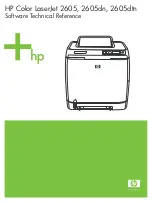
CX-Supervisor Performance monitor
Appendix C Troubleshooting
300
C.4.1 Overview
Shows an overview of the headline performance of all other components.
C.4.2 Summary
Provides a Summary view, totalising and averaging property values from all
PLCs on all networks.
C.4.3 CPU Time
Lists specific CPU and process information including processing times for all
scripts and all callbacks.
C.4.4 Network
Totalises properties for all PLCs on each network.
C.4.5 PLC
The 'PLC Average Latency (ms)' field shows the physical delay of the network
and PLC response time. Depending on the PLC, setup and network this
should be 9-30ms. If this is drastically higher it could be the cause of
performance problems. Try some of the following steps to reduce it:
The 'PLC Average Latency (ms)' field shows the physical delay of the network
and PLC response time. Depending on the PLC, setup and network this
should be 9-30ms. If this is drastically higher it could be the cause of
performance problems. Try some of the following steps to reduce it:
•
Test on a dedicated network, or if not possible with other nodes disabled.
This is to ensure it is not due to network loading or other external factors.
•
Try with the PLC in 'STOP' mode. If this has an impact double-check the
PLC settings. This can vary depending on PLC type, but some require a
longer scan rate, so more free CPU time is available to service the
communications, whereas some require a shorter scan rate so the
communications are service more frequently at the end of each scan.
Some other settings may also impact the CPUs ability to service
communications.
•
Try to reduce the number of active messages (see below)
•
Try to reduce to % usage (see below)
On the Performance tab, the quantity of 'Active Messages' is shown. Each
Active Message is a single communication request although the internal
optimisations mean that many continuously addressed points can be read in
one message. This depends on the frame size, which in turn depends on the
network type. This is why use of arrays and good memory layout are essential
to performance. To reduce the Active Messages see Chapter 16 Best
Practices, Performance and Chapter 16 Best Practices, Points.
On the Performance tab, the current and historic usage is shown. 100% usage
is rarely seen and the system may be running at capacity well before this. This
is analogous to a motorway where cars slow down long before they are
touching bumpers, and might only achieve 50% of capacity (each car has a
car length space behind it). In practical terms, for serial connections consider
70-80% the limit. For Ethernet packet collisions start occurring above 30% and
are automatically corrected, but 40-50% is the practical limit. For Controller
Link, which has a vast bandwidth, any value above 10% signals a
performance issue. To reduce the % usage see Chapter 16 Best Practices,
Performance and Chapter 16 Best Practices, Points.
Summary of Contents for CX-Supervisor
Page 1: ...CX Supervisor Software Cat No W10E EN 01 User Manual Software Release 3 1...
Page 3: ...Copyright Notice 2...
Page 16: ...15...
Page 17: ...16...
Page 27: ...Tip of the Day SECTION 1 Graphics Editor 26...
Page 35: ...CX Supervisor Preferences SECTION 2 Pages 34...
Page 79: ...Responding to Events SECTION 5 ActiveX Objects 78...
Page 115: ...Printing the Graphics Library SECTION 7 Graphics Library 114...
Page 181: ...Data Logging SECTION 11 Data Logging 180...
Page 201: ...Examples SECTION 12 Databases 200...
Page 243: ...Performance Monitor SECTION 16 Application Analysis Performance Monitor 242...
Page 253: ...Using with Omron s CX Server OPC SECTION 17 Using CX Supervisor as an OPC Cli 252...
Page 259: ...Creating a CX Supervisor Client application SECTION 18 Connecting to a remote CX 258...
Page 263: ...Adding a Point Linked to a Parameter SECTION 19 Connecting to Omron Industrial 262...
Page 271: ...Data Logging SECTION 20 Best Practices 270...
Page 275: ...Configuring a Server PC running Windows NT or 2000 Appendix A Configuring a PC 274...
Page 277: ...Appendix B Frequently Asked Questions 276...
Page 296: ...Appendix B Frequently Asked Questions 295...
Page 297: ...Appendix B Frequently Asked Questions 296...
Page 298: ...Appendix B Frequently Asked Questions 297...
Page 299: ...Appendix B Frequently Asked Questions 298...
Page 333: ...Revision history 332...
















































